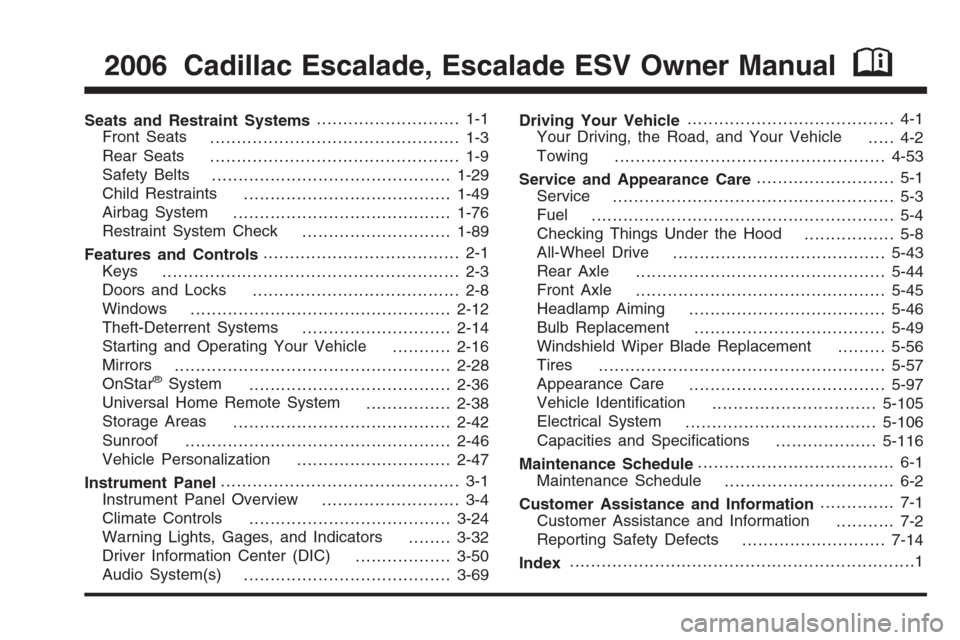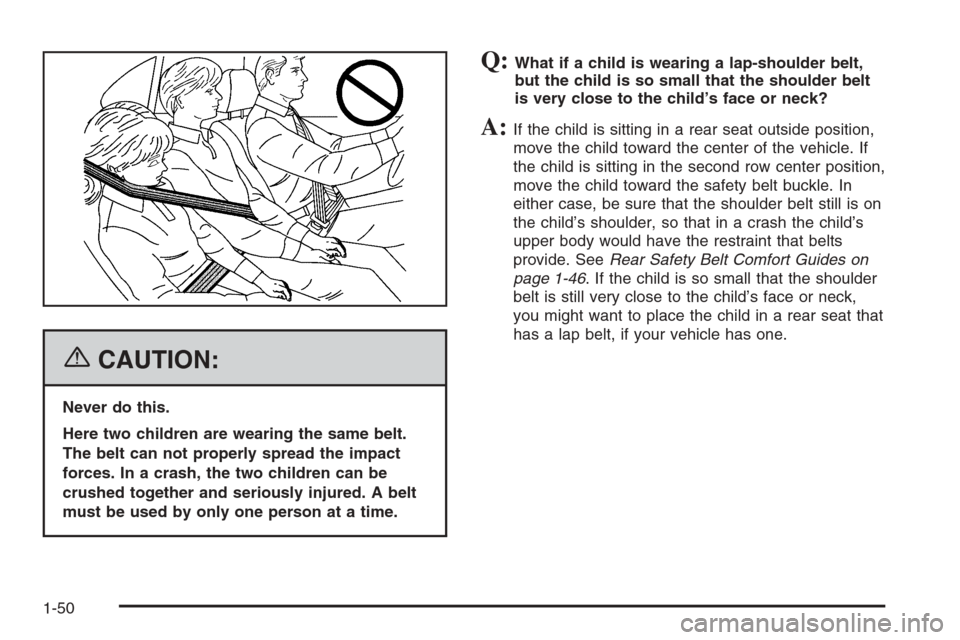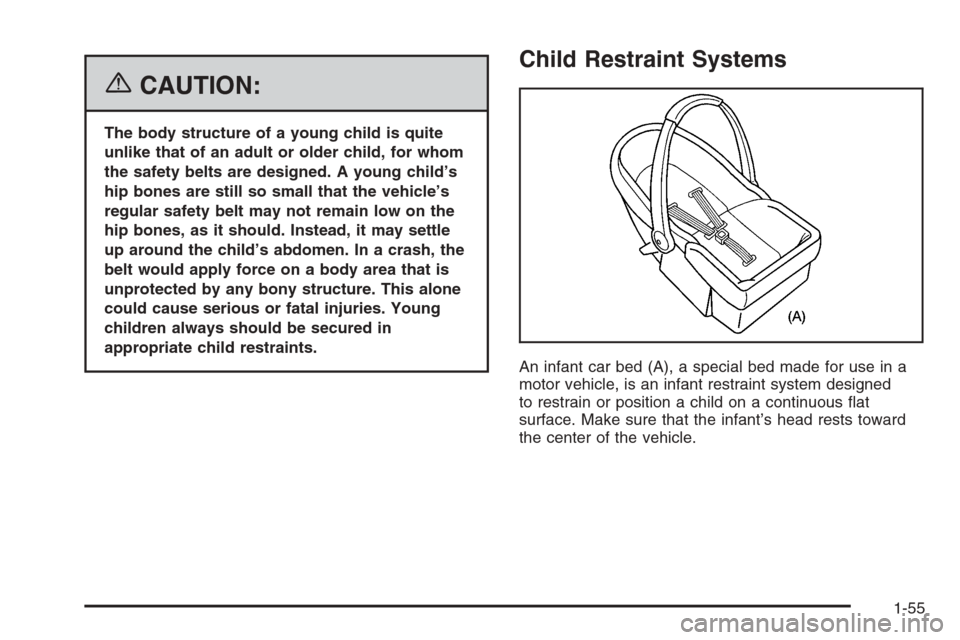tow CADILLAC ESCALADE ESV 2006 2.G Owners Manual
[x] Cancel search | Manufacturer: CADILLAC, Model Year: 2006, Model line: ESCALADE ESV, Model: CADILLAC ESCALADE ESV 2006 2.GPages: 484, PDF Size: 2.84 MB
Page 1 of 484

Seats and Restraint Systems........................... 1-1
Front Seats
............................................... 1-3
Rear Seats
............................................... 1-9
Safety Belts
.............................................1-29
Child Restraints
.......................................1-49
Airbag System
.........................................1-76
Restraint System Check
............................1-89
Features and Controls..................................... 2-1
Keys
........................................................ 2-3
Doors and Locks
....................................... 2-8
Windows
.................................................2-12
Theft-Deterrent Systems
............................2-14
Starting and Operating Your Vehicle
...........2-16
Mirrors
....................................................2-28
OnStar
®System
......................................2-36
Universal Home Remote System
................2-38
Storage Areas
.........................................2-42
Sunroof
..................................................2-46
Vehicle Personalization
.............................2-47
Instrument Panel............................................. 3-1
Instrument Panel Overview
.......................... 3-4
Climate Controls
......................................3-24
Warning Lights, Gages, and Indicators
........3-32
Driver Information Center (DIC)
..................3-50
Audio System(s)
.......................................3-69Driving Your Vehicle....................................... 4-1
Your Driving, the Road, and Your Vehicle
..... 4-2
Towing
...................................................4-53
Service and Appearance Care.......................... 5-1
Service
..................................................... 5-3
Fuel
......................................................... 5-4
Checking Things Under the Hood
................. 5-8
All-Wheel Drive
........................................5-43
Rear Axle
...............................................5-44
Front Axle
...............................................5-45
Headlamp Aiming
.....................................5-46
Bulb Replacement
....................................5-49
Windshield Wiper Blade Replacement
.........5-56
Tires
......................................................5-57
Appearance Care
.....................................5-97
Vehicle Identi�cation
...............................5-105
Electrical System
....................................5-106
Capacities and Speci�cations
...................5-116
Maintenance Schedule..................................... 6-1
Maintenance Schedule
................................ 6-2
Customer Assistance and Information.............. 7-1
Customer Assistance and Information
........... 7-2
Reporting Safety Defects
...........................7-14
Index.................................................................1
2006 Cadillac Escalade, Escalade ESV Owner ManualM
Page 12 of 484

I(Seatback Only):This can only be used for the
heat feature. Press this button to heat the seatback
and cycle through the heat settings of high, medium,
low and off. Red indicator lights will glow for each heat
setting chosen: three lights for high, two for medium
and one for low. A light in the button will also glow
to indicate the seatback heat is on.
J(Entire Seat):Press this button to heat or cool the
entire seat and cycle through the settings of high,
medium, low and off. Red (for heat) or blue (for cool)
indicator lights will glow for each setting chosen:
three lights for high, two for medium and one for low.
Reclining Seatbacks
Power Reclining Seatbacks
The front seats have power reclining seatbacks. Use
the vertical power seat control located on the outboard
side of the seat(s) to operate them.
To recline the seatback, press the control toward
the rear of the vehicle.
To raise the seatback, press the control toward the
front of the vehicle.
1-6
Page 16 of 484

Extended Models
The passenger’s side of both the second row 60/40 split
bench seat and the second row bucket seat has an
easy entry/exit feature. This makes it easy to get in and
out of the third row seat.
To operate the easy entry seat, do the following:
1. Lift the release lever on the outboard side of the
back of the seat.
2. Tilt the seatback toward the front of the vehicle and
the seat will release.
3. Pull (push if you are exiting the third row with no
assistance) the seat forward until it stops.{CAUTION:
A safety belt that is improperly routed, not
properly attached, or twisted will not provide
the protection needed in a crash. The person
wearing the belt could be seriously injured.
After raising the rear seatback, always check
to be sure that the safety belts are properly
routed and attached, and are not twisted.
{CAUTION:
If the seatback is not locked, it could move
forward in a sudden stop or crash. That could
cause injury to the person sitting there. Always
push and pull on the seatback to be sure it is
locked.
Return the seat to the normal seating position when
�nished. Push and pull on the seatback to make sure it
is locked in place.
1-10
Page 23 of 484

Returning the 50/50 Split Bench Seat(s)
from a Tilted Position
To return the seat to the normal seating position, do the
following:
1. Open the liftgate to access the controls for the
50/50 seat(s).
2. Pull the lever labeled 3 toward you.
3. While still holding the lever 3 toward you, grasp the
top of the seat and pull it toward you slightly.4. Let go of lever 3 and pull the seat completely down.
5. Push down on the seat �rmly. Try pulling it up to
make sure it is locked in place.
6. Pull up on the release lever labeled 1, located on
the rear of the seatback. Then pull up on either the
seatback or the assist strap, located on the
outboard side of the seat, until the seatback locks
into the upright position.
{CAUTION:
If the seatback is not locked, it could move
forward in a sudden stop or crash. That could
cause injury to the person sitting there. Always
push and pull on the seatback to be sure it is
locked.
7. Push and pull the seatback to make sure it is
locked.
1-17
Page 28 of 484

{CAUTION:
If the support rod is not properly engaged, the
folded third row seat could come loose in a
sudden stop or crash. That could cause injury
to people and damage to your vehicle. Always
be sure the support rod is properly engaged
when the third row seat is folded forward.
6. While holding the seat
forward, pull the
support rod out from
the retainer clips
and �ip it down until it
latches into place.
The seat will now remain in the upright position.
Place the seat in this position only when necessary
for additional cargo space.
Returning the Bench Seat from a Tilted
Position
To return the seat to the normal seating position, do the
following:
1. Open the liftgate to access the controls for the
bench seat and enter the rear of the vehicle.
2. Pull the lever on the
support rod bracket
until it unlatches from
the seat bracket.
3. Place the support rod back into the storage position.
4. Pull the seat toward you and push �rmly down
until the seat latches in the �oor.
5. Lift up on the seat to make sure it is locked into
place.
1-22
Page 56 of 484

{CAUTION:
Never do this.
Here two children are wearing the same belt.
The belt can not properly spread the impact
forces. In a crash, the two children can be
crushed together and seriously injured. A belt
must be used by only one person at a time.
Q:What if a child is wearing a lap-shoulder belt,
but the child is so small that the shoulder belt
is very close to the child’s face or neck?
A:If the child is sitting in a rear seat outside position,
move the child toward the center of the vehicle. If
the child is sitting in the second row center position,
move the child toward the safety belt buckle. In
either case, be sure that the shoulder belt still is on
the child’s shoulder, so that in a crash the child’s
upper body would have the restraint that belts
provide. SeeRear Safety Belt Comfort Guides on
page 1-46. If the child is so small that the shoulder
belt is still very close to the child’s face or neck,
you might want to place the child in a rear seat that
has a lap belt, if your vehicle has one.
1-50
Page 61 of 484

{CAUTION:
The body structure of a young child is quite
unlike that of an adult or older child, for whom
the safety belts are designed. A young child’s
hip bones are still so small that the vehicle’s
regular safety belt may not remain low on the
hip bones, as it should. Instead, it may settle
up around the child’s abdomen. In a crash, the
belt would apply force on a body area that is
unprotected by any bony structure. This alone
could cause serious or fatal injuries. Young
children always should be secured in
appropriate child restraints.
Child Restraint Systems
An infant car bed (A), a special bed made for use in a
motor vehicle, is an infant restraint system designed
to restrain or position a child on a continuous �at
surface. Make sure that the infant’s head rests toward
the center of the vehicle.
1-55
Page 88 of 484

How Does an Airbag Restrain?
In moderate to severe frontal or near frontal collisions,
even belted occupants can contact the steering wheel or
the instrument panel. In moderate to severe side
collisions, even belted occupants can contact the inside
of the vehicle. The airbag supplements the protection
provided by safety belts. Airbags distribute the force of
the impact more evenly over the occupant’s upper body,
stopping the occupant more gradually. But the frontal
airbags would not help you in many types of collisions,
including rollovers, rear impacts, and many side impacts,
primarily because an occupant’s motion is not toward the
airbag. Side impact airbags would not help you in many
types of collisions, including many frontal or near frontal
collisions, and rear impacts, primarily because an
occupant’s motion is not toward those airbags. Airbags
should never be regarded as anything more than a
supplement to safety belts, and then only in moderate to
severe frontal or near-frontal collisions for the frontal
airbags, and only in moderate to severe side collisions for
vehicles with a side impact airbag.
What Will You See After an Airbag
In�ates?
After the airbag in�ates, it quickly de�ates, so quickly
that some people may not even realize the airbag
in�ated. Some components of the airbag module may
be hot for a short time. These components include
the steering wheel hub for the driver’s frontal airbag and
the instrument panel for the right front passenger’s
frontal airbag. For side impact airbags, the side of the
seatback closest to the driver’s and/or right front
passenger’s door may be hot. The parts of the bag that
come into contact with you may be warm, but not too
hot to touch. There will be some smoke and dust coming
from the vents in the de�ated airbags. Airbag in�ation
does not prevent the driver from seeing or being able to
steer the vehicle, nor does it stop people from leaving
the vehicle.
1-82
Page 93 of 484

{CAUTION:
If the airbag readiness light in the instrument
panel cluster ever comes on and stays on, it
means that something may be wrong with the
airbag system. If this ever happens, have the
CAUTION: (Continued)
CAUTION: (Continued)
vehicle serviced promptly, because an
adult-size person sitting in the right front
passenger’s seat may not have the protection
of the frontal airbag. SeeAirbag Readiness
Light on page 3-35for more on this, including
important safety information.
Aftermarket equipment, such as seat covers, can affect
how well the passenger sensing system operates.
You may want to consider not using seat covers or other
aftermarket equipment if your vehicle has the passenger
sensing system. SeeAdding Equipment to Your
Airbag-Equipped Vehicle on page 1-88for more
information about modi�cations that can affect how the
system operates.
{CAUTION:
Stowing of articles under the passenger’s
seat or between the passenger’s seat cushion
and seatback may interfere with the proper
operation of the passenger sensing system.
1-87
Page 97 of 484

Keys...............................................................2-3
Remote Keyless Entry System.........................2-4
Remote Keyless Entry System Operation...........2-5
Doors and Locks.............................................2-8
Door Locks....................................................2-8
Power Door Locks..........................................2-9
Delayed Locking.............................................2-9
Programmable Automatic Door Locks..............2-10
Rear Door Security Locks..............................2-10
Lockout Protection........................................2-10
Liftgate/Liftglass............................................2-11
Windows........................................................2-12
Power Windows............................................2-13
Sun Visors...................................................2-14
Theft-Deterrent Systems..................................2-14
Content Theft-Deterrent.................................2-14
Passlock
®....................................................2-16Starting and Operating Your Vehicle................2-16
New Vehicle Break-In....................................2-16
Ignition Positions..........................................2-17
Retained Accessory Power (RAP)...................2-17
Starting the Engine.......................................2-18
Adjustable Throttle and Brake Pedal................2-19
Engine Coolant Heater..................................2-19
Automatic Transmission Operation...................2-20
Tow/Haul Mode............................................2-23
Parking Brake..............................................2-23
Shifting Into Park (P).....................................2-24
Shifting Out of Park (P).................................2-25
Parking Over Things That Burn.......................2-26
Engine Exhaust............................................2-26
Running the Engine While Parked...................2-27
Section 2 Features and Controls
2-1